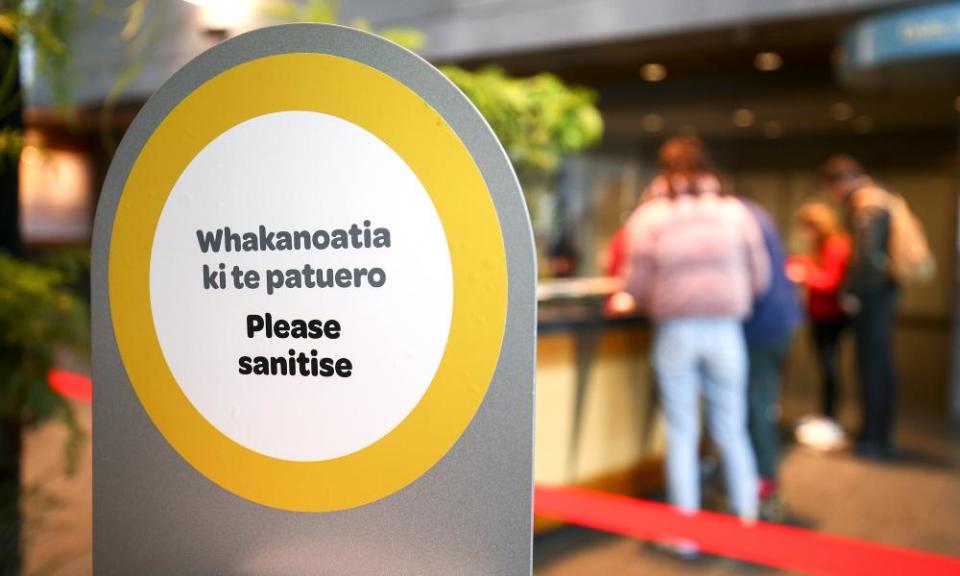'A matter of when not if': New Zealand begins battle against 'Covid fatigue'

Customers stream into a central Wellington cafe, past a QR code posted on the door that allows people to check in on the New Zealand government’s Covid-19 tracing app. None pause to pull out their phones. Down the footpath outside, crosses of tape – denoting physical distancing measures for shoppers that ended months ago – feel like a reminder of a bad dream.
New Zealand has attained the status of one of the world’s safest countries when it comes to the coronavirus; there is no known community transmission in the country and life has largely returned to normal. But with one eye on nations where the virus was once quashed before spiralling out of control again, officials and the government have changed their language in recent days in order to fight a new battle – this time against complacency.
“We have to be absolutely on our toes,” Ashley Bloomfield, New Zealand’s top health official, said in a Radio New Zealand interview on Wednesday. “That’s not just the health system … it’s everybody.”
It has been 96 days since the last domestic case of Covid-19 was transmitted from an unknown source in New Zealand; all 24 diagnosed instances of the virus are among travellers returning to the country who are in quarantine at government-managed isolation hotels. But it was inevitable, Bloomfield said on Wednesday, that New Zealand would have an outbreak beyond the isolation facilities.
Related: New Zealand unemployment at 4% in surprise fall during coronavirus pandemic
“It’s a matter of when, not if,” he said. “We’re working on the basis that it could be any time.”
His words were less gentle than some earlier remarks from the authorities. The health minister, Chris Hipkins, also warned this week against “Covid fatigue” among the population, urging “constant vigilance”.
A strict lockdown of the country in March and April quashed the spread of the virus, with fewer than 1,500 cases confirmed and 22 deaths. All restrictions on daily life except border controls were lifted two months ago.
Jacinda Ardern, the prime minister, told reporters that New Zealanders “cannot afford to be complacent” in a news conference on Monday. Ardern referred to the Australian state of Victoria, where border failures have led to a resurgence of community transmission, provoking the state’s strictest lockdown yet.
“They too had very low numbers for a number of days in June,” she said. “We are dialling back up the Covid messaging in response to some behaviours we’re seeing in New Zealand.”
The message is people should wash their hands, stay home if sick, accept Covid-19 tests where offered – a survey of doctors showed 25% of those offered were declining the swabs – and use the government contact tracing app. Less than 13% of the country’s population has downloaded it, according to official figures.
In the capital, Wellington, on Wednesday, even some people who had downloaded the app admitted that they weren’t using it. It was hard to remember to do so with few reminders of Covid-19 in their daily lives, they said, and some did not want to believe there could be a resurgence of the virus in New Zealand.
“I was using it when I saw the codes at first but I haven’t swiped it in ages,” says James Thompson. “It’s probably kind of that I forgot and kind of that it just doesn’t seem that important now.”

Not every business displays the QR codes for the government app, and making it compulsory was “not off the table”, Bloomfield said on Wednesday. The health ministry is also reconsidering its guidance on masks – during lockdown, officials did not recommend them, in line with WHO advice at the time – and the government has bolstered testing for those who work at the borders and redoubled its efforts to test for undetected community transmission.
On Wednesday, Megan Woods, the minister responsible for the isolation hotels for returning travellers from other countries, revealed there had been seven instances of guards at the facilities falling asleep on the job. With a handful of quarantined travellers escaping the hotels, it was easy to see how one slip – or a series of slips, as was the case in Victoria – could change New Zealand’s fortunes.
Related: New Zealand and Cook Islands work on 'travel bridge' to beat tourism slump
New Zealand’s government is “not taking seriously enough the need for military type procedures for quarantine”, says Tony Blakely, a University of Otago epidemiologist based in Melbourne. “It’s not a holiday camp.”
Watch video below
Officials should also ensure the system was “running incredibly smoothly”, he adds, with contact-tracing capacity ready to be scaled to full-speed within 24 hours, fast and wide-ranging local lockdowns when cases emerged, and a national drill day for people to practice wearing masks since they had not been required before.
“You act hard, fast, early, and with a huge amount of precaution,” he says. “Otherwise all that work that New Zealand did to achieve elimination would just go up in flames.”
In the meantime, experts say, New Zealanders will have to keep walking a tightrope of heeding advice while not allowing themselves to be overwhelmed by worry.
“It’s not completely irrational for people to relax and it’s quite hard for people to exist in a hyper alert mode … it’s possibly not even healthy,” says Nick Wilson an associate professor in public health at the University of Otago. “You have two states, you relax and live life normally or you’re hyper-vigilant and alert.”
If 5 million people were “a bit extra-stressed”, he adds, “it’s not good.”

 Yahoo News
Yahoo News 
